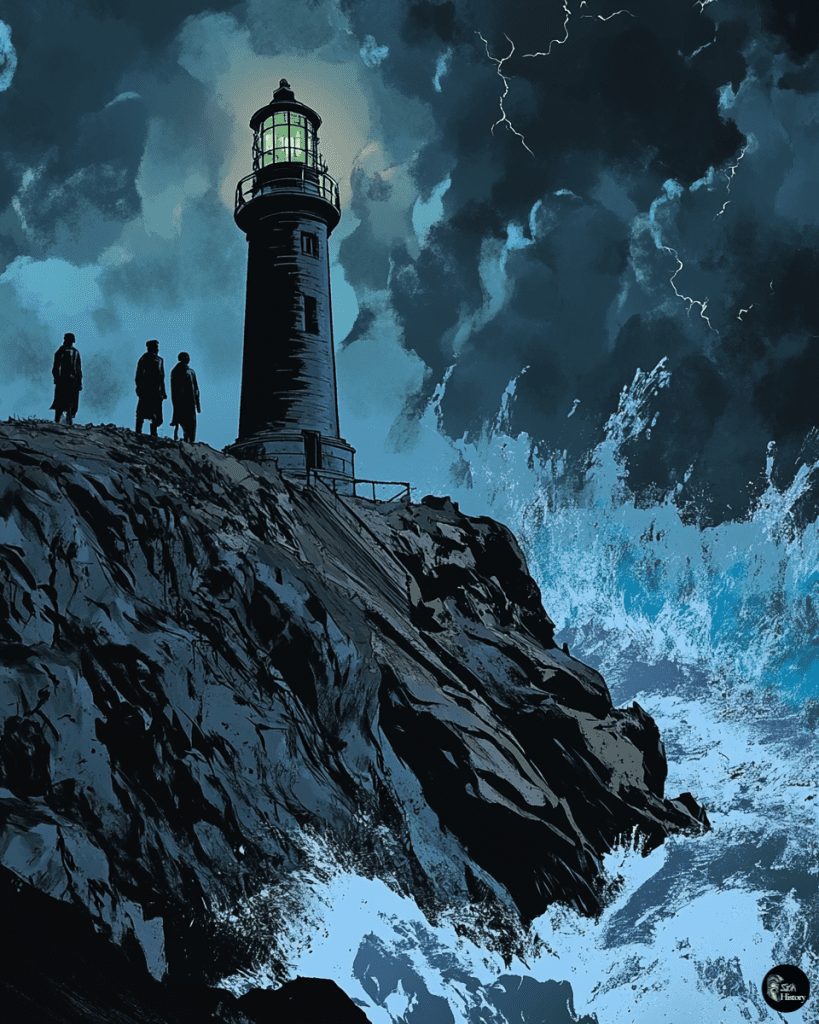The Flannan Isle Lighthouse stands as a silent sentinel on a remote Scottish island, guarding ships against treacherous waters. In December 1900, this isolated outpost became the center of a perplexing mystery that continues to captivate imaginations over a century later.
Three lighthouse keepers – James Ducat, Thomas Marshall, and Donald McArthur – vanished without a trace from their post on Eilean Mor, leaving behind an enigma that has never been fully solved. The disappearance of these men sparked numerous theories and investigations, but the truth remains elusive.
The Flannan Isle mystery has inspired countless stories, poems, and even musical works. It raises questions about the harsh realities faced by lighthouse keepers in remote locations and the unforgiving power of nature.
The events surrounding this incident continue to fascinate those intrigued by unsolved historical mysteries.
The Flannan Isles Lighthouse Mystery
The disappearance of three lighthouse keepers from the Flannan Isles Lighthouse in December 1900 remains one of Scotland’s most enduring maritime mysteries. This baffling incident has sparked numerous theories and investigations over the years.
Timeline of Events
On December 15, 1900, the last log entry was made at the Flannan Isle Lighthouse. James Ducat, Thomas Marshall, and Donald McArthur were on duty at the time.
The lighthouse’s light was reported dark on December 15.
However, due to bad weather, a relief vessel couldn’t reach the island until December 26.
Upon arrival, Joseph Moore, the relief keeper, found the lighthouse empty. The last meal remained untouched on the table, and two sets of oilskins were missing.
Key Figures
James Ducat, Thomas Marshall, and Donald McArthur were the three keepers who vanished. Ducat was an experienced Principal Keeper, while Marshall served as the Second Assistant.
Joseph Moore, the relief keeper, made the initial discovery of the empty lighthouse. His report sparked the investigation.
Captain Harvie commanded the Hesperus, the vessel that brought Moore to the island. He played a crucial role in the initial search and reporting of the incident.
Theories and Investigations
Multiple theories have emerged to explain the keepers’ disappearance.
One suggests they were swept away by a freak wave while trying to secure equipment during a storm.
Another theory proposes that one keeper went mad and killed the others before taking his own life. However, no evidence supports this claim.
The Northern Lighthouse Board conducted an official investigation. They concluded the men were likely blown over the cliffs or drowned trying to secure a crane or other equipment during severe weather.
Despite numerous investigations, the true fate of the three lighthouse keepers remains unknown, cementing the Flannan Isles Lighthouse Mystery in Scottish folklore.
Geographical and Historical Context
The Flannan Isles and their lighthouse are steeped in maritime history and rugged Scottish geography. Their remote location and harsh conditions set the stage for one of Scotland’s most enduring mysteries.
Flannan Isle Geography
The Flannan Isles, also known as the Seven Hunters, are a small archipelago in Scotland’s Outer Hebrides. They lie approximately 20 miles west of the Isle of Lewis.
The largest island, Eilean Mòr, hosts the Flannan Isles Lighthouse.
These uninhabited islands are characterized by steep cliffs and challenging terrain. Eilean Mòr rises to 288 feet above sea level, and sheer rock faces dominate its coastline.
Access to the islands is notoriously difficult due to frequent storms and treacherous waters. Landing is only possible in calm weather, adding to their isolation.
Lighthouse History
The Flannan Isles Lighthouse was built between 1895 and 1899 to aid navigation in the dangerous waters of the North Atlantic. It began operating in 1899 and stands 75 feet tall on Eilean Mòr’s highest point.
The lighthouse was designed by David Alan Stevenson, part of the famous Stevenson family of Scottish lighthouse engineers. Given its remote location and harsh conditions, its construction was a remarkable feat.
Initially manned by three keepers, the lighthouse required constant attention to maintain its critical warning beacon. Keepers rotated shifts, spending weeks at a time on the isolated island.
The Northern Lighthouse Board
The Northern Lighthouse Board (NLB), established in 1786, oversees the Flannan Isles Lighthouse. This organization manages all lighthouses around Scotland and the Isle of Man.
The NLB was responsible for the lighthouse’s construction, staffing, and maintenance. They appointed keepers, scheduled rotations, and conducted regular inspections.
In 1900, the NLB faced its most perplexing case when three keepers vanished without explanation. This incident led to significant changes in lighthouse management and safety protocols.
Aftermath and Legacy
The Flannan Isle lighthouse keeper disappearance left a lasting impact on lighthouse operations and popular culture. It prompted changes in safety protocols and inspired numerous artistic works.
Subsequent Safety Measures
The Northern Lighthouse Board implemented several changes after the incident.
They increased the number of keepers stationed at remote lighthouses from three to four. This ensured a minimum of two keepers would always be present.
Communication protocols were enhanced. Regular check-ins with the mainland became mandatory. Emergency procedures were revised and clarified.
The Board also improved weather monitoring systems at isolated lighthouses. This allowed keepers to better prepare for severe storms.
Cultural Impact
The Flannan Isle mystery captured the public imagination and inspired various artistic works.
Wilfrid Wilson Gibson’s 1912 poem “Flannan Isle” brought widespread attention to the event.
Several books explored the disappearance, offering theories and fictional accounts.
Notable works include “The Lighthouse Stevensons” by Bella Bathurst and “The Lamplighters” by Emma Stonex.
The incident influenced films and television shows.
It served as inspiration for episodes of “Doctor Who” and “Survivors“.
A 2018 film, “The Vanishing“, starring Gerard Butler, dramatized the event.
The mystery continues to fascinate, spawning documentaries, podcasts, and online discussions.
It remains a popular subject for conspiracy theorists and paranormal enthusiasts.

